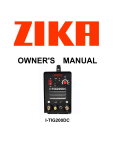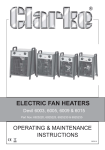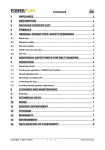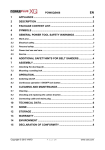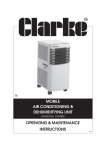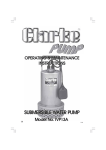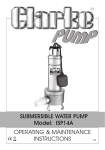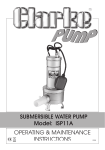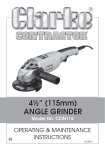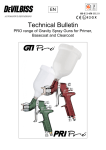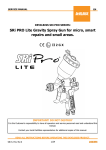Download Clarke INDY OIL FREE Specifications
Transcript
INDY OIL FREE AIR COMPRESSOR OPERATION & MAINTENANCE INSTRUCTIONS Serial/Batch No: ....................... 009050502 THIS PAGE LEFT INTENTIONALLY BLANK Please note that the details and specifications contained herein are correct at the time of going to print. However CLARKE International reserve the right to change specifications at any time without prior notice. Always consult the machines data plate -2- -19 - INDY AIR COMPRESSOR Thank you for purchasing this Clarke Indy Air Compressor. Before attempting to operate the machine, please read this instruction manual thoroughly and carefully follow all directions given. This is for your own safety and that of others around you, and also to help you achieve long and trouble free service from your compressor. Guarantee This product is guaranteed against faults in manufacture for 12 months from purchase date. Please keep your receipt as proof of purchase. This guarantee is invalid if the product has been abused or tampered with in any way, or not used for the purpose for which it is intended. The reason for return must be clearly stated. This guarantee does not affect your statutory rights. Contents Page Safety Precautions ................................................................ 4 Electrical Connections ......................................................... 5 Operating Instructions .......................................................... 6 General Arrangement ......................................................... 7 Paint Spraying Hints .................................................. 8,9 & 10 Routine Maintenance ........................................................ 11 Fault finding ......................................................................... 12 Technical data ................................................................... 13 Shutting down the compressor ......................................... 13 Parts List & Diagrams - (JS Spraygun) ...................... 14 & 15 Parts List & Diagrams - ( Compressor) ..................... 16 & 17 Declaration of Conformity ................................................ 18 -18- -3- Safety Precautions PARTS LIST (Compressor) WARNING! Compressed air can be dangerous. Follow these safety instructions carefully. No Description Qty No Description Qty 1 Screw 4 28 Hose Adapter 1 2 Compressor Head 1 31 Hose 1 3 Gasket 1 33 Pressure Gauge 1 4 Valve 1 34 Disk 1 5 Valve Plate 1 35 Screw 1 Air compressors work at high pressure. Inspect equipment and hoses regularly, checking for any damage or leaks. Have any damage properly repaired before using the machine again. 6 Gasket 1 36 Filter retainer 1 7 Screw 1 37 Air Filter 1 • Do not operate the compressor with any guards removed. 8 Piston Segment 1 38 Motor 1 • Do not adjust or tamper with the safety valve in any way. The maximum working pressure (115 psi - approximately 8 bar) is clearly marked on the compressor and air receiver. 9 Con-Rod 1 39 Bearing 1 10 Screw 4 40 On/Off Press Rel Valve 1 11 Crankcase 1 41 Pressure Gauge 1 • • • Never direct a jet of compressed air at people or animals, or spray paint towards people or animals. Use appropriate protective equipment, such as Clarke safetygoggles or glasses, dust masks, ear defenders etc. when using compressed air tools. • The compressor will become hot during operation. Do not touch the cylinder head or discharge pipe while the compressor is in use. 12 Eccentric Shaft 1 42 Valve Block 1 • Always close the air outlet valve and release any pressure from the air hose (by operating the tool briefly) before disconnecting any hoses or tools. 13 Screw 4 43 Hose adapter 1 14 Base Plate 1 44 Pressure Rel Valve 1 When paint spraying: 15 Screw 1 45 Olive 1 Always wear a suitably approved breathing mask when paint spraying, to protect against inhalation of paint spray or fumes. An airfeed mask may be required when spraying some types of paint. If in doubt, check the paint manufacturers instructions. 17 Fan 1 46 Hose Connector 1 18 Motor Shaft 1 47 Hose 1 19 Capacitor 1 48 Hose Clamp 1 • Make sure there is adequate ventilation. Do not spray in confined or enclosed areas. 20 Plastic Cover 1 49 Hose 1 21 Bayonet Conn Nut 1 50 Power Cable 1 • Many paints are flammable. Do not smoke while spraying or preparing paints, or spray near a naked flame or heat source. 22 Tap 1 51 Cable 1 25 Pressure Regulator Assy 1 • -4- -17 - Electrical Connections PARTS DIAGRAM (Compressor) 230 Volt models: Connect the mains lead to a standard 230 Volt (50Hz) electrical supply through an approved BS1363, 13amp plug or a suitably fused isolator switch. 110 Volt models: Connect the mains lead to a suitable 110 Volt (50Hz) electrical supply through an approved plug or a suitably fused isolator switch. If using a portable 110 Volt transformer make sure it has a rated capacity sufficient to take the load of the compressor (See Data Plate). All models: We recommend that the compressor is connected to the mains supply through a Residual Current Device (RCD). WARNING! THIS APPLIANCE MUST BE EARTHED IMPORTANT: The wires in the mains lead are coloured in accordance with the following code: Green & Yellow Earth Blue Neutral Brown Live As the colours of the flexible cord of this appliance may not correspond with the coloured markings identifying terminals in your plug proceed as follows: • Connect GREEN & YELLOW cord to terminal marked with a letter “E” or Earth symbol “ ” or coloured GREEN or GREEN & YELLOW. • Connect BROWN cord to terminal marked with a letter ‘L’ or coloured RED • Connect BLUE cord to terminal marked with a letter ’N’ or coloured BLACK 230 Volt models: If this appliance is fitted with a plug which is moulded onto the electric cable (i.e. non- rewirable) please note: 1. The plug must be thrown away if cut from the electric cable. There is a danger of electric shock if it is subsequently inserted into a socket. 2. Never use the plug without the fuse cover fitted. 3. Should you wish to replace a detachable fuse carrier, ensure that the correct replacement is used (as indicated by marking or colour code). 4. Replacement fuse covers can be obtained from your local dealer or most electrical stockists. 5. The fuse in the plug must be replaced with one of the same rating (13amps) and this replacement must be ASTA approved to BS1362. If in doubt, consult a qualified electrician....DO NOT attempt repairs yourself -16 - -5- OPERATION (Numbers in brackets refer to fig 1. Page 6) PARTS LIST (JS Spraygun) Item No 1. Check that the mains voltage corresponds to that shown on the data sticker on the crankcase cover (5). 2. Ensure that the on/off switch (4) is set to off, position ‘O’ and all air is expelled from the compressor by opening the outlet tap (3). 3. Plug in and switch on the main electrical supply. 4. To start the compressor, switch the on/off switch (4) to on, position ‘I’, the motor should start immediately. 5. Before connecting your airline to the compressor, allow it to run for a few seconds with the air outlet tap (3) fully open. 6. Close the air outlet tap, DO NOT OVERTIGHTEN, connect one end of suitable air hose to the compressor , and the other end to the equipment being used.Set the operating pressure by adjust ing the regulator knob (1). To do this pull the knobupwardsand adjust by turning (clockwise to increase and anti-clockwise to decrease). When the required pressure is reached on the pressure gauge (2) push the knob down again to hold the setting. NOTE: For most spray work, do not exceed 30psi (unless following paint manufacturers instructions). For other airline equipment such as tyre gauges, paraffin guns etc, it may be necessary to set the air pressure at a higher or (lower) level. 7. With operating pressure set, re-open the air outlet tap. ACCESSORIES Your Indy Air Compressor can be used in conjunction with a range of optional accessories, for inflating tyres, air brushing, stapling blowing and many other uses, For further details, please contact your nearest dealer. Description Qty 1 Air Cap Ring 1 2 Air Cap 1 3 Air Cap 1 4 Fluid Tip 1 5 Washer 1 6 Packing Nut 1 7 Needle 1 8 Spring 1 9 Cap 1 10 Paint Feed Pipe 1 11 Container Gasket 1 13 Paint Container 1 14 Trigger 1 15 Pin 1 17 Nipple ¼” 1 18 Quick Release Nut 1 PARTS & SERVICE TEL: 020 8988 7400 or e-mail as follows: PARTS: [email protected] SERVICE: [email protected] -6- -15 - PARTS DIAGRAM (JS Spraygun) INDY SPRAY OUTFIT 1. Pressure regulator knob. 2. Pressure gauge. (not shown) 3. Air outlet tap. 7. Recoil air hose. 4. On/Off switch. 8. JS Spraygun. 5. Crank case cover. -14 - 6. Mains Lead. -7- PAINT SPRAYING HINTS TECHNICAL DATA WARNING Model Indy Air - (Oil Free) Maximum Air Pressure 115 PSI Air Displacement 3.5 CFM Motor ½ HP Voltage 230 vac & 110 vac Weight 9.6 kg (Packed) Part Number Air Indy 110 Vac 3230071 e. Ensure surface to be painted is clean, dry and free from oil and dust. Check paint manufacturer’s instructions for any special surface preparation required. Part Number Air Indy 230 vac 2320070 REMEMBER - TIME SPENT PREPARING SAVES TIME SPENT FINISHING Dimensions (mm) 340 x 150 x 270 NEVER attempt to spray unless you are wearing suitable, approved respiratory and eye protection. REMEMBER that some modern paints require specialist respiratory protection...always consult the paint manufacturers instructions. 1. GENERAL PREPARATION a. Ensure that the area in which you will be spraying is clean and dust free. b. Connect spray gun to compressor via suitable flexible hose. c. With no paint in spray gun, test system for air leaks. d. Cover adjacent pieces of equipment to prevent overspray. Mask areas of the article not to be sprayed. 2. PAINT PREPARATION a. Achieve the correct paint viscosity. This should be done according to paint manufacturer’s instructions, and will vary according to type of paint. b. Having mixed the paint thoroughly in a separate container, pour into the spray gun paint container through a fine filter. SHUTTING DOWN THE COMPRESSOR SHUTTING DOWN THE COMPRESSOR DO NOT OVERFILL SPRAY GUN PAINT CONTAINER - three quarters full is maximum c. It is usually best to experiment with a couple of practice spray coats on a piece of material with the same type of surface as the article you wish to spray, eg. metal for a car body panel, wood for a piece of furniture etc. d. Some common problems: PROBLEM Paint does not atomise (comes out in blobs) CAUSE Paint is too thick, air pressure is too low. Paint dries before hitting Paint is too thin. Air surface, leaving it dry pressure is too high with a rough texture Finish is pitted like Orange peel work CORRECTION 1. Ensure that the on/off switch is in the off -’O’ position. NEVER USE THE MAINS SWITCH TO STOP THE MOTOR. 2. Depress equipment trigger (spraygun) to release air from the hose and compressor before disconnecting from the machine. 3. Switch off and remove mains. Add thinners. Increase air press. (not above 50 psi, unless specified by paint manuf. Add more paint. Reduce air pressure Air pressure too high Reduce air pressure, or spray too close to increase distance between gun and work. -8- -13 - PAINT SPRAYING HINTS Cont FAULT FINDING With considerate use, your CLARKE Air Compressor should provide you with long and trouble free service. Routine checks should be made on both the electrical supply as well as the compressed air lines and connections. If any fault appears, the reason for which is not immediately obvious, please contact your local CLARKE Dealer. PROBLEM The compressor stops and will not start again. PROBABLE CAUSE REMEDY Bad connections. Check electrical connections. Clean and tighten as necessary. Overload cutout switch has tripped. Switch off and wait 5 Motor windings burnt out. Contact your local dealer for a replacement motor. The compressor does not reach the set pressure and overheats easily. Compressor head gasket blown or valve broken. Contact your CLARKE dealer. Compressor does not start. Compressed air i cylinder head PAINT THINNING For a professional looking finish paint must be thinned. If manufacturers recommendations on thinning are not available, the following can be used as a general guide. Water based paints (emulsions) 10-20% water. Oil based paints (gloss) up to 10% thinners. Cellulose paints up to 50 % cellulose thinners. HANDLING THE GUN minutes before switching on. Replace Piston (contact your CLARKE dealer) Turn the air outlet tap off and disconnect hose (if fitted). Open the outlet tap and expel air from cylinder head. Restart the first requirement for a good resultant finish is the proper handling of the gun. The gun should be perpendicular to the surface being covered and moved parallel with it. The stroke should be started before the trigger is pulled and likewise , released before the stroke is ended. This gives accurate control of the gun and material. The distance between the gun and the surface to be covered should be 6 to 12 inches depending on the material and atomising pressure. The material deposited should always be even and wet. Lap each stroke over the preceding stroke to obtain a uniform finish. NOTE: To reduce overspray and obtain maximum efficiency, always spray with the lowest possible atomising air pressure. CAUTION Do not attempt any repair or adjustment if you are uncertain as to how it should be done. If you have any queries, contact your local CLARKE Dealer. -12 - -9- PAINT SPRAYING HINTS Cont ROUTINE MAINTENANCE IMPORTANT Before attempting to service or carry out any maintenance or repairs on your Indy air compressor, always ensure that the unit is disconnected from the main electrical supply, i.e. mains plug removed, also ensure that all air has been expelled from the cylinder head. SPRAY GUN MAINTENANCE NOTE: After the first 5 hours operation, check that all nuts and bolts are tight, paying special care to the compressor head and crankcase. 1) Immerse only the front end of the gun until solvent just covers the fluid connection. To keep your Indy compressor working efficiently, periodic servicing is necessary, follow the service schedules below. 2) Use a bristle brush and solvent to wash off accumulated paint. 3) Do Not submerge the entire spray gun in solvent because: Monthly: a) The lubricant in the leather packings will dissolve and the packings will dry out. Remove and clean the air intake filter element (37) (this should be carried out more frequently if the compressor is used in dusty atmospheres). b) The lubricant at wear surfaces will dissolve causing harder operation and faster wear. With SPONGE ELEMENTS gently blow clean with compressed air or wash in solution of household detergent. c) Residue from dirty solvent may clog the narrow air passages in the gun. 4) Wipe down the outside of the gun with a solvent dampened cloth. 5) Lubricate the gun daily. Use a light machine oil on: Rinse and dry thoroughly before re-fitting. Remember that a dirty filter prevents adequate aspiration and adversely affects the efficiency of your compressor. a) fluid needle packing. WARNING: b) Air valve packing. Never operate the compressor without the air intake filter fitted. c) Fan control packing. YEARLY or 1000 HRS: d) Trigger pivot point. Coat the fluid control spring with vaseline. 6) Caution: Never use lubricants containing silicone. This material may cause contamination, leading to finish defects. Replace the air intake element. EVERY 2 YEARS or 2000 HRS: Check and clean the intake and delivery valves. WARNING: When components are removed for servicing always take the opportunity to fit new seals. In the event of an air leak, follow the procedure below:a) Load the compressor to the maximum pressure. b) Un-plug the compressor from the main electrical supply. c) Using a brush and soapy water, wet all ‘’screwed’’ connections. (Take care not to wet any electrical component). d) Any leaks will show up through the formation of bubbles. NEVER UNSCREW A COMPRESSOR CONNECTION WHILE THE MACHINE IS UNDER PRESSURE. ALWAYS MAKE CERTAIN ALL AIR IS EXPELLED BEFORE DOING SO . -10 - -11-










